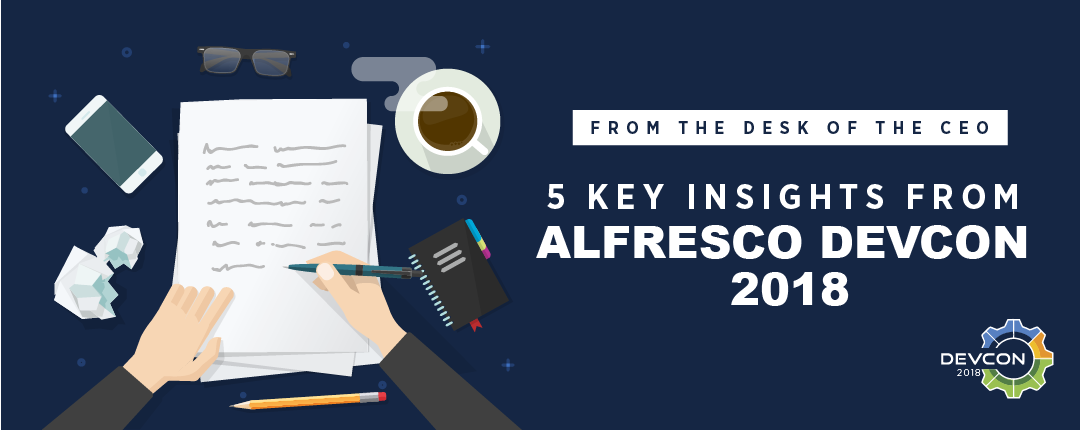5 Key Insights from Alfresco DevCon 2018
Recently in Lisbon, Portugal Alfresco hosted a conference for its community of developers. It was great to see Alfresco get back to supporting this passionate community of developers and architects from partners, customers, and employees. I’ve tried to keep this insightful without sounding too much like a sales communication. Humor me, I’m very proud of my team and their accomplishments.
The first key insight from the event is that Alfresco is well positioned with its cloud-ready story. Thomas DeMeo, VP Product Management, and Brian Remmington, Chief Architect, shared Alfresco’s product roadmap and direction to start the conference. It is clear that the AWS partnership is critical to both companies as demonstrated by the release time frames throughout 2018 showing continued development on AWS innovation and integration. Additionally, Alfresco continues to redefine its architecture for a cloud environment. Zia architects have shared in more depth how Alfresco is rebuilding its digital business platform. I believe this is a very good strategic direction for Alfresco and agree with separating the user interface functionality (Share and ADF—more on this later) from the rest of the digital business platform. I also agree with separating the content, process, and governance services platforms into a microservice architecture that can be deployed on AWS using Kubernetes and Docker. Zia is working with a number of customers to build applications with Docker and create massive deployments using Kubernetes to deploy, scale, and manage their digital business platform solutions. Note: Docker deployment is not currently supported for Alfresco Content Services. Alfresco is actively working towards providing Docker, Kubernetes, and Helm support in the near future. We have been able to collaborate with Alfresco, other community members, and our customers to make early progress in these areas.
Our customers support Alfresco moving to this cloud first architecture as well. A number of our customers are receiving edicts from their CIOs to move away from capital expenditures and running data centers. I’ll provide another blog series on the Zia approach to hybrid cloud architectures that explains how we are helping our customers with their digital transformation and cloud first initiatives. We have some exciting case studies to share how we are integrating cloud content management platforms like Box, cloud friendly ECM platforms like Alfresco, and mainframe to cloud and back platforms like ASG Mobius. Disclaimer, sales plug here: Most of our customers have all three types of technologies today and want a hybrid solution to consolidate legacy applications from Documentum, IBM, and Opentext. You can find out more on our cloud services page.
The second insight from DevCon is that Alfresco remains committed to open source, community development and open APIs. Forrester recently published an excellent total economic impact (TEI) with Alfresco and AWS which provides details on how customers of AWS and Alfresco can achieve a 148% return on investment from moving to these two technologies. There are too many insights from that TEI for this blog, but DevCon highlighted several of them. First, open source software and open APIs allow companies, partners, and product companies to very quickly and effectively (meaning less development and maintenance costs) integrate to existing line of business systems, other ECM systems, and custom applications. Second, you can use lower cost team members to manage these systems. Note, you still need a darn good system integrator to help you build it correctly. If you build it wrong, you might need our rescue practice team. DevCon highlighted the healthy community of partners and developers working on Alfresco and AWS. There are active partnerships and development in the Alfresco community that support Salesforce and remove the need for shadow IT with integrations to technologies like Box. There was a lot of exciting work expanding the use of Apache ManifoldCF, an open source framework for connecting source content repositories like Alfresco, SharePoint, and Documentum, to target repositories or indexes, such as Apache Solr, Open Search Server, or ElasticSearch. The last, and certainly most relevant for the Zia geek night crew, has to be the ContentCraft project from Alfresco Product Owner, Governance Services, and Founding Engineer, Roy Wetherall, that provides an extension to Minecraft.
The third insight I had from DevCon was music to my ears—Alfresco is publicly acknowledging it is a platform company! Alfresco’s product management leadership was addressing concerns about the future of Share, Jeff Potts wrote an excellent article on this already, and shared with the team that they intend to focus on creating a leading content, process, and governance platform rather than user interfaces. To paraphrase further, they blatantly stated that they were not very good at building UIs and didn’t want to be in that business. Our customers share Jeff’s well stated concern, especially if they have built and extended Share-based applications for the past several years. The reason I’m excited about this development is because it fits into Zia’s view of the world for hybrid ECM architectures. We help our customers use existing investments in technologies like line of business applications, cloud ECM investments, mobile and mainframe applications to build new cloud architectures that leverage the best tools to complete the job.
My fourth insight from DevCon is the most relevant for our customers. If you are looking for digital transformation, be very careful where you invest time and money in new content platforms. If you are investing in legacy applications like Documentum, IBM, Oracle, and Opentext platforms you are seriously putting your company’s future digital transformation initiatives at risk. I am not advocating a rip and replace approach to this, however, I am recommending that our customers seriously consider a hybrid approach and cloud first as part of their strategy. For example, Nathan McMinn presented a talk about using AWS, IOT, and Alfresco Process Services to work on an open data initiative with the city of Birmingham. There is a Code for America Brigade based in Birmingham. The goal of this organization is to organize, develop, and deploy civic technology by volunteering and collaborating with the city. I pressed Nathan on scalability concerns regarding Alfresco Content Services, frankly I didn’t think it or process services would scale to handle an IoT load. Nathan agreed and we discussed a couple of hybrid cloud architectures using AWS Lambda functions, APS, and cloud data repositories that can handle high volume IoT data. This is an approach you can consider with Alfresco.
I particularly enjoyed listening to McDermott’s CTO, Vagesh Dave, discuss several goals and insights from their digital transformation initiatives. McDermott, like most companies, has several content repositories and they believe they have squeezed all of the traditional efficiency levers you can exploit from these systems and process improvement initiatives in years past. They need platforms that integrate with and replace some of their existing ECM technologies. A few of the business outcomes they are looking to achieve create long-term savings, predictable maintenance costs, improve operating margins, and create innovative new business models and offerings. The approach they are taking to achieve this is similar to what we advocated this past year to our customers for approaching digital transformation. The first two steps towards digital transformation are to digitize your content and look for opportunities to automate manual processes. This will drive further opportunities for insight and innovation through automation. The anticipated outcome for these two steps is to achieve predictable operating costs, long-term savings, and improved operating margins. The benefits of unlocking your legacy data (old image files, archives, and siloed content) to gain valuable business insights have been proven time and again.
Next, create hybrid cloud architectures that offer the best in employee and customer engagement. This requires giving your users (customers AND employees) tools they love to use, global and remote access that is secure, and giving yourself the ability to be agile in changing how you approach business problems. The last step, other than continually iterating over these processes and improving them, is to mine your data for valuable insights using analytics and artificial intelligence. John Newton, CTO of Alfresco, spoke about the impact of new technologies on the future of content management. Our customers will not be able to leverage these new tools if they don’t migrate and create digital content in ECM repositories that provide open APIs and access.
In summary, if an organization is looking for digital transformation and cloud first initiatives because of the benefits I discussed above, then work with open business partners. Businesses that are digital leaders recognize they need to focus on their core business and not on running data centers. There are simply too many things to be experts in these days. The truth is you need trusted partners that can help you make decisions on how to best leverage technologies like Box, mainframe applications, SharePoint, legacy ECM products, and the Alfresco Digital Business Platform. Product companies that make a point to openly integrate with other technologies benefit our customers. Alfresco started out this way and has continued to make good on its promise to provide open, standards-based access to their content. This has created growth and innovation opportunities for my business, our product partners, and most importantly our customers.


